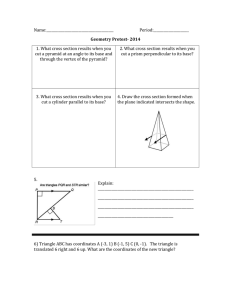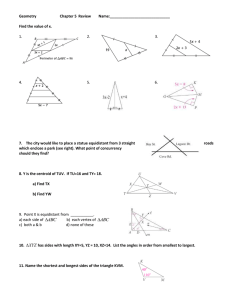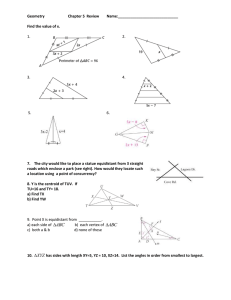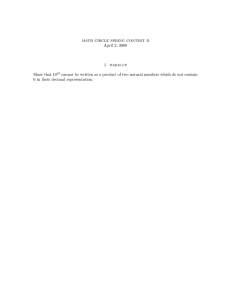INNOVATIONS IN THE MATHEMATICS TEACHING IN SECONDARY SCHOOL
advertisement
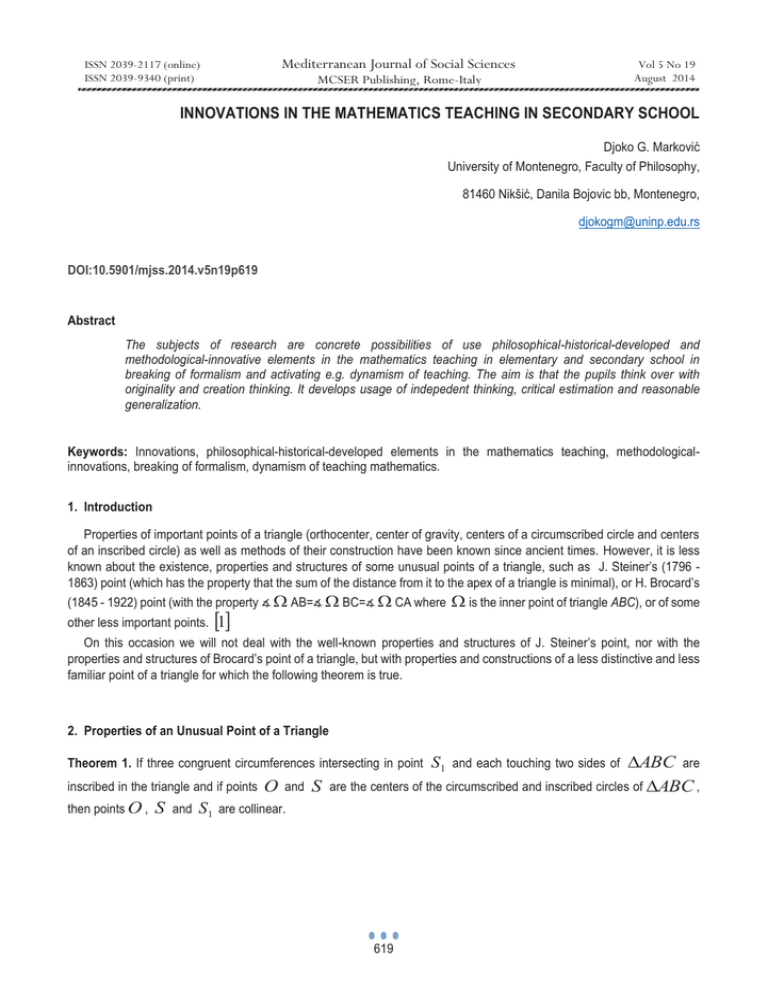
Mediterranean Journal of Social Sciences
ISSN 2039-2117 (online)
ISSN 2039-9340 (print)
MCSER Publishing, Rome-Italy
Vol 5 No 19
August 2014
INNOVATIONS IN THE MATHEMATICS TEACHING IN SECONDARY SCHOOL
Djoko G. Marković
University of Montenegro, Faculty of Philosophy,
81460 Nikšić, Danila Bojovic bb, Montenegro,
djokogm@uninp.edu.rs
DOI:10.5901/mjss.2014.v5n19p619
Abstract
The subjects of research are concrete possibilities of use philosophical-historical-developed and
methodological-innovative elements in the mathematics teaching in elementary and secondary school in
breaking of formalism and activating e.g. dynamism of teaching. The aim is that the pupils think over with
originality and creation thinking. It develops usage of indepedent thinking, critical estimation and reasonable
generalization.
Keywords: Innovations, philosophical-historical-developed elements in the mathematics teaching, methodologicalinnovations, breaking of formalism, dynamism of teaching mathematics.
1. Introduction
Properties of important points of a triangle (orthocenter, center of gravity, centers of a circumscribed circle and centers
of an inscribed circle) as well as methods of their construction have been known since ancient times. However, it is less
known about the existence, properties and structures of some unusual points of a triangle, such as J. Steiner’s (1796 1863) point (which has the property that the sum of the distance from it to the apex of a triangle is minimal), or H. Brocard’s
(1845 - 1922) point (with the property ע: AB= ע: BC= ע: CA where : is the inner point of triangle ABC), or of some
other less important points.
>1@
On this occasion we will not deal with the well-known properties and structures of J. Steiner’s point, nor with the
properties and structures of Brocard’s point of a triangle, but with properties and constructions of a less distinctive and less
familiar point of a triangle for which the following theorem is true.
2. Properties of an Unusual Point of a Triangle
Theorem 1. If three congruent circumferences intersecting in point
inscribed in the triangle and if points
then points O ,
S
and
O
and
S
S1 and each touching two sides of 'ABC are
are the centers of the circumscribed and inscribed circles of 'ABC ,
S1 are collinear.
619
Mediterranean Journal of Social Sciences
ISSN 2039-2117 (online)
ISSN 2039-9340 (print)
Vol 5 No 19
August 2014
MCSER Publishing, Rome-Italy
Proof:
Let us designate with points
A1 , B1
and
C1 centers of the given congruent circumferences. It is easy to notice that
they belong to the bisectors of the interior angles in
'ABC
similar way, we conclude that
B1C1 ║ BC,
A1C1 ║ AC
and
(see figure 1).
from which follows that
have common bisectors of the interior angles, that is they have one common center
to note that a homothety H with center
k
S
('A1B1C1 )
S1 A1
S1 B1
'ABC,
where
k
B1G A1B1 ║ AB . In the
A1 L
S
'ABC
and
'A1B1C1
of the inscribed circles. It is easy
S and coefficient k maps 'A1B1C1 into 'ABC , i.e. H
AB
. However, since we have that, according to the given problem,
A1B1
S1C1 , point S1 is the center of the circumscribed circle around 'A1 B1C1. Since 'ABC and
'A1 B1C1 are homothetic, the circles circumscribed around them are also homothetic, therefore we have that H
k
S
( S1 )
O, i.e. points O, S1
and
S
are collinear, which was to be proven.
C
x
C1
S
x A1
S1
x
x O
L
A
B1
G
B
K (O,r )
Figure 1.
Property of colinearity of points
O, S1 and S
enables us to construct point
S1 , that is to solve the following problem.
3. Constructions of an unusual point of a triangle
2. Inscribe (construct) in the given triangle
ABC
three congruent circumferences intersecting in point
circumference touches two sides of the triangle.
620
S1 , where each
Mediterranean Journal of Social Sciences
ISSN 2039-2117 (online)
ISSN 2039-9340 (print)
Vol 5 No 19
August 2014
MCSER Publishing, Rome-Italy
Analysis: According to the previous theorem, we have that a homothety H with center
'A1B1C1
k
AB
A1 B1
'ABC ,
into
BC
B1C1
CA
C1 A1
In order to construct the requested point
k
HS
i.e.
SA
SA1
SO
SS1
('A1B1C1 )
S
and coefficient
k
'ABC,
maps
where
(see figure 1).
S1 of the given triangle it is necessary and sufficient to find the homothety (similarity)
coeficient.
For that purpose, we construct a figure similar (homothetic) to the one in picture 1. That figure given in picture 2 consists of a
pair of homothetic triangles
'A0 B0 C 0 and 'A2 B2 C 2
a corresponding pair of homothetic triangles
'ABC
and
which due to similarity to the figure in picture 1, i.e. similarity to
'A1 B1C1 have the same homothety coefficient k .
We obtain this figure by constructing in the following way:
First let us construct any
'A0 B0 C 0
which is similar to a pair of homothetic triangles
which will concurrently be homothetic with triangle
coefficient
k
k
, i.e. H S
0
('A0 B0 C 0 )
'A1 B1C1 , and
'A2 B2 C 2 .
of its interior angles in whose intersection is found point
S0
'A0 B0 C 0 , that is let us construct bisectors
- the center of the circle inscribed in
construct bisectors of its sides in whose intersection is found point
'A0 B0 C 0 ), with centers A0 , B0
and
is easy to construct common tangents ( A2 B 2 ) ,
C0
'A0 B0 C 0 , and let us
S 2 - the center of its circumscribed circle (see figure 2).
Let us construct three congruent circumferences which have one common point
triangle
and
A2 B2 C 2 , where the center of that homothety is point S 0 , and
Let us construct centers of inscribed and circumscribed circles in and around
around
'ABC
S 2 (the center of the circumscribed circle
and with equal radiuses
A0 S 2
B0 S 2
C0 S 2
y . It
( A2 C 2 ) and ( B2 C 2 ) on pairs of those circumferences that generate
A2 B2 C 2 homothetic with 'A0 B0 C 0 .
Since the homothetic figure in picture 2 is constructed in the way that it is similar to the homothetic figure in picture 1, it means
that the homothety coefficent is.
k
AB
A1 B1
BC
B1C1
CA
C1 A1
SA
SA1
SO
SS1
A2 B2
A0 B0
621
B2 C 2
B0 C 0
C 2 A2
C 0 A0
S 0 A2
S 0 A0
S 0 O0
S0 S2
Mediterranean Journal of Social Sciences
ISSN 2039-2117 (online)
ISSN 2039-9340 (print)
Vol 5 No 19
August 2014
MCSER Publishing, Rome-Italy
Construction (first way):
Through analysis we found that a pair of homothetic triangles ( 'A0 B0 C 0 and
'A2 B2 C 2 ) of the figure in picture 2
has the homothety coefficient that equals the one of a pair of corresponding homothetic triangles ( 'ABC and
'A1 B1C1
) of the figure in picture 1, i.e.
S S0
S1
S2
A0
O
O0
A2
Figure 3.
S 0 A2
S 0 A0
k
S 0 O0
S0 S2
S 0O
, therefore we can easily construct the requested segment S 0 S1 .
SS1
Let us observe a part of the construction in figure 2, precisely let us construct a pair of corresponding homothetic triangles
separately ( 'S 0 A2 O0 and
Triangle
ABC
'S 0 A0 S 2 ) (see figure 3).
is given and we can easily construct points
(the intersection of bisectors of its interior angles) and
O
(the intersection of bisectors of its sides) (see figure 4). Homothety H with center S and coefficient k maps 'A1 B1C1
AB
BC
CA
SA SO
k
into 'ABC , i.e. H S ('A1B1C1 ) 'ABC, where k
.
A1B1 B1C1 C1 A1 SA1 SS1
Therefore, in figure 4, point
SO
and since
center
S { S0
k
k
S1 is to be constructed, that is the segment SS1
SO
SS1
, we can circumscribe in figure 3 a circle K
and a radius
H S ('A2 O0 O)
S
S 0O
S 0 S1 . As we constructed a segment
( S 0 , S 0 O)
with a center in the homothety
SO . With this homothety, points A0 , S 2 , S1 match points A2 , O0 , O , i.e.
'A0 S 2 S1 . Point S1
is obtained as intersection of straight lines
( S 0 O)
and
( A0 S2 ) , i.e.
( S 0 O) ( A0 S 2 ) . Thus we constructed segment S 0 S1 # SS1 and on segment SO we easily find the
requested point S1 of triangle ABC. In the similar way we can construct vertexes of 'A1 B1C1 , and thus the three
congruent circumferences in 'ABC that have the common intersection in point S1 (figure 4).
S1
622
Mediterranean Journal of Social Sciences
ISSN 2039-2117 (online)
ISSN 2039-9340 (print)
Vol 5 No 19
August 2014
MCSER Publishing, Rome-Italy
C
x
x
C1
S
x
S1
A1
x
B1
x
O
A
B
Figure 4.
Construction of the requested point could have been done in the following way as well:
Let us construct again a pair of homothetic triangles ( 'A0 B0 C 0 and
'ABC
then let us construct
in homothety with
'A2 B2 C 2 ) of the figure as in picture 2, and
'A2 B2 C 2 . It is clear that in this case their homologous
(corresponding) sides are parallel. Center V of a new homothety is found in intersection of pencils of straight lines
( AA2 ) ( BB2 ) (CC2 ) ( SS0 ) V , where the coefficient of this homothety (similarity) is
k1
VA
VA2
Therefore, point
VB
VB2
VC
VC2
VS
VS0
, then we have H V1 ('ABC)
k
'A2 B2 C2
k
and H V1 ( S1 )
S1 is found in intersection of straight lines (VS 2 ) and (SO) , i.e. (VS 2 ) ( SO )
the construction of point
S1 , and
S1 is thus completed (see figure 5).
However, we have that H V1 ('A1 B1C1 )
k
(VA0 ) ( SA)
S2 .
A1 , (VB0 ) ( SB)
'A0 B0 C0 , and:
B1 , (VC0 ) (SC) C1 , therefore we can construct
S1 in a third way as a center of a circle circumscribed around 'A1B1C1 .
623
point
Mediterranean Journal of Social Sciences
ISSN 2039-2117 (online)
ISSN 2039-9340 (print)
Vol 5 No 19
August 2014
MCSER Publishing, Rome-Italy
V
C2
y
S2
A0
y O0
y
C0
C
S0
y
B0
y
B2
A2
x
x
C1
S
x
S1
A1
x
B1
x
O
A
B
Slika 5.
Proof:
Proof ensues from analysis and construction.
Discussion:
Since point
S1 as the center of the circumscribed circle around 'A1B1C1 is single (only one), the problem has only
one solution.
Such innovations presented in classes of teaching in high school result in students’ increased interest in independent
research or creative work and serve for eradicating formalism and activating or dynamazing the teaching process with
talented students.
624
ISSN 2039-2117 (online)
ISSN 2039-9340 (print)
Mediterranean Journal of Social Sciences
MCSER Publishing, Rome-Italy
Vol 5 No 19
August 2014
REFERENCES
M. Bozic, (2002), Survey of the history and philosophy of mathematics, Institute for Textbooks and Teaching Aids, Belgrade.
G. Polya, (1966), How do I solve mathematical problems, school books, Zagreb, Croatia.
Marković, Đoko G. (2006). Geometrical polymorphism (Geometrijski polimorfiza.) (Serbian), Nast. Mat. 51, No. 3-4, 11-24.
Đ. G. Markovic, (2008), New views on methods of teaching mathematics, M3 Macarius, Podgorica.
625

